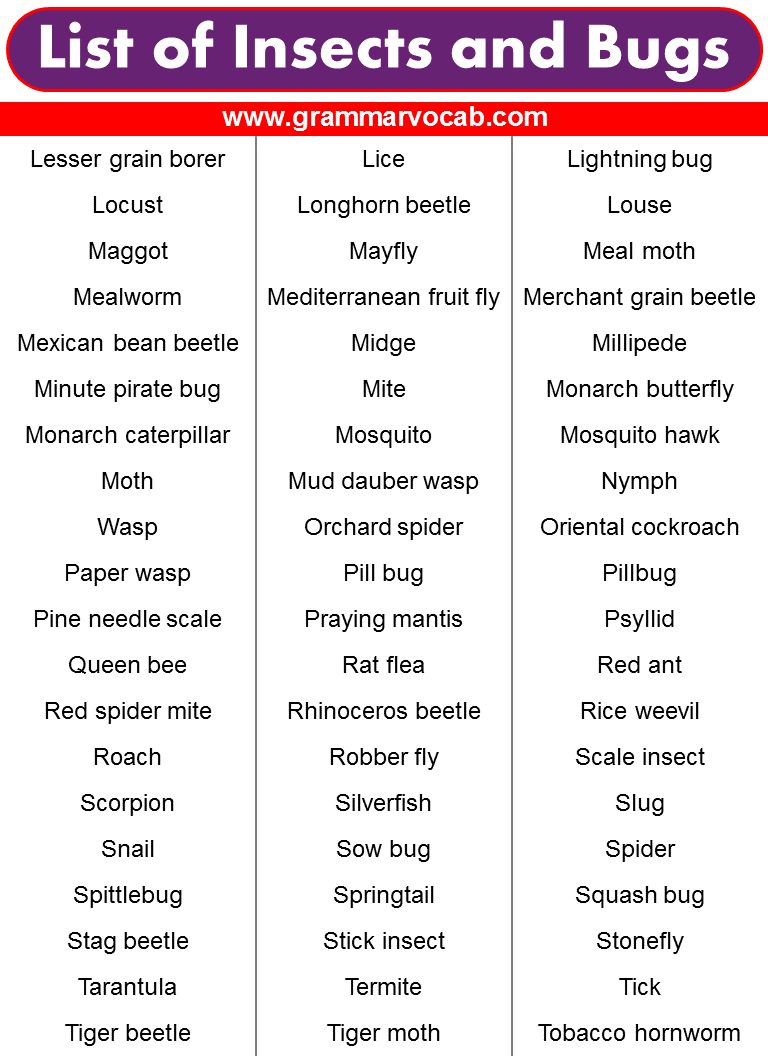Insects and bugs are fascinating creatures that play vital roles in our ecosystem. They belong to the class Insecta, which is the largest class of arthropods and comprises approximately 90% of all animal species on Earth. Insects and bugs are incredibly diverse, with over a million known species, and scientists estimate that there may be as many as 30 million more species waiting to be discovered. These tiny creatures come in a range of shapes, sizes, and colors, and can be found in almost every habitat on the planet, from the depths of the ocean to the highest mountaintops. In this blog post, we will explore the list of insects and bugs that inhabit our world.
Names of Insects and Bugs
- Aedes aegypti
- African painted bug
- Africanized honey bee
- Alates
- Alderfly
- Ambush bug
- American cockroach
- American dog tick
- Anopheles mosquito
- Ant
- Aphid
- Apple maggot fly
- Arrowhead scale
- Ash borer
- Assassin bug
- Bagworm
- Bagworm moth
- Banded woolly bear
- Bark beetle
- Bed bug
- Bee
- Bee fly
- Beetle
- Big-eyed bug
- Birch leafminer
- Black ant
- Black carpet beetle
- Black fly
- Black vine weevil
- Blacklegged tick
- Black-legged tick
- Blister beetle
- Blowfly
- Bluebottle fly
- Blue-green sharpshooter
- Boll weevil
- Boxelder bug
- Boxwood leafminer
- Broad mite
- Brown marmorated stink bug
- Brown recluse spider
- Buckeye butterfly
- Butterfly
- Cabbage looper
- Caddisfly
- California oakworm
- California red scale
- Camel cricket
- Carpenter ant
- Carpet beetle
- Caterpillar
- Centipede
- Chigger
- Chocolate moth
- Cicada
- Citrus whitefly
- Click beetle
- Cluster fly
- Cockroach
- Colorado potato beetle
- Common green lacewing
- Common house spider
- Conehead termite
- Conenose bug
- Cranefly
- Crayfish
- Cricket
- Cuckoo wasp
- Daddy longlegs
- Darkling beetle
- Deathwatch beetle
- Deer tick
- Dobsonfly
- Dog flea
- Dragonfly
- Earwig
- Eastern tent caterpillar
- Emerald ash borer
- European hornet
- False chinch bug
- Field cricket
- Fire ant
- Firefly
- Flea
- Flesh fly
- Fly
- Fruit fly
- Fungus gnat
- Giant water bug
- Glassy-winged sharpshooter
- Glowworm
- Gnat
- Grain beetle
- Grape berry moth
- Grape flea beetle
- Grasshopper
- Green lacewing
- Green stink bug
- Ground beetle
- Gypsy moth
- Harlequin bug
- Harvester ant
- Head lice
- Hickory horned devil
- Hister beetle
- Honey bee
- Honeybee
- Hornet
- Horsefly
- House cricket
- Housefly
- Ichneumon wasp
- Indian meal moth
- Japanese beetle
- Jewel wasp
- June bug
- Katydid
- Ladybug
- Larch sawfly
- Leaf miner
- Leaf-footed bug
- Leafhopper
- Leech
- Lesser grain borer
- Lice
- Lightning bug
- Locust
- Longhorn beetle
- Louse
- Luna moth
- Lygus bug
- Madagascar hissing cockroach
- Maggot
- Mayfly
- Meal moth
- Mealworm
- Mediterranean fruit fly
- Merchant grain beetle
- Mexican bean beetle
- Midge
- Millipede
- Minute pirate bug
- Mite
- Monarch butterfly
- Monarch caterpillar
- Mosquito
- Mosquito hawk
- Moth
- Mud dauber wasp
- Nymph
- Oak processionary caterpillar
- Orchard spider
- Oriental cockroach
- Paper wasp
- Pill bug
- Pillbug
- Pine needle scale
- Praying mantis
- Psyllid
- Queen bee
- Rat flea
- Red ant
- Red spider mite
- Rhinoceros beetle
- Rice weevil
- Roach
- Robber fly
- Scale insect
- Scorpion
- Silverfish
- Slug
- Snail
- Sow bug
- Spider
- Spittlebug
- Springtail
- Squash bug
- Stag beetle
- Stick insect
- Stonefly
- Tarantula
- Termite
- Tick
- Tiger beetle
- Tiger moth
- Tobacco hornworm
- Tomato hornworm
- True bug
- Tsetse fly
- Walking stick
- Wasp
- Water bug
- Water strider
- Weaver ant
- Webworm
- Weevil
- Western conifer seed bug
- Whitefly
- Widow spider
- Wolf spider
- Yellowjacket
- Zebra butterfly
Are All Bugs Insects?
No, not all bugs are insects. In common language, the term “bug” is often used to refer to any small creeping or flying creature, including insects, arachnids, and other small invertebrates.
However, in scientific terms, “bug” refers to insects belonging to the order Hemiptera, which includes true bugs such as stink bugs, bed bugs, and cicadas. These insects have mouthparts adapted for piercing and sucking, and many of them have distinctive shield-shaped bodies.
So while all insects are bugs in common language, not all bugs are insects in scientific terms.
Why are insects called bugs?
The term “bug” originally referred to a specific type of insect – the bed bug (Cimex lectularius). The word “bug” is thought to have originated from the Middle English word “bugge,” which referred to a type of ghost or hobgoblin. The term “bugge” was later applied to insects, especially bed bugs, which were commonly found in homes and associated with nighttime nuisances.
Over time, the term “bug” became a more general term for any small, creeping, or crawling insect. Today, the word “bug” is often used interchangeably with “insect,” although technically not all insects are considered bugs. Bugs are a specific order of insects known as Hemiptera, which are characterized by their piercing and sucking mouthparts and forewings that are thickened at the base and membranous at the tip.
In summary, insects are often called bugs because of the historical association with bed bugs and the gradual expansion of the term to include other small, crawling or creeping insects.
What insects are not bugs?
In everyday language, people often use the term “bug” to refer to any small crawling or flying creature, but in biological terms, the word “bug” specifically refers to a group of insects called Hemiptera, which includes true bugs such as stink bugs, cicadas, and aphids.
Therefore, there are many insects that are not bugs. Some examples include:
- Beetles: Beetles belong to the order Coleoptera and are characterized by their hard, protective forewings, which cover their membranous hind wings.
- Butterflies and moths: Butterflies and moths belong to the order Lepidoptera and are known for their delicate wings covered in scales.
- Ants, bees, and wasps: Ants, bees, and wasps belong to the order Hymenoptera and are characterized by their narrow waist and ability to sting.
- Flies: Flies belong to the order Diptera and are known for their single pair of wings and ability to fly quickly.
- Grasshoppers and crickets: Grasshoppers and crickets belong to the order Orthoptera and are characterized by their long hind legs, which they use for jumping.
There are many more examples of insects that are not bugs, but these are some of the most common ones.
Difference Between Insect And Bug
The terms “insect” and “bug” are often used interchangeably, but they actually refer to slightly different things.
Insects are a class of invertebrates that are characterized by having three body segments (head, thorax, and abdomen), three pairs of legs, and often two pairs of wings. Insects include a wide variety of species, such as butterflies, beetles, ants, bees, and grasshoppers.
A bug, on the other hand, is a specific type of insect that belongs to the order Hemiptera. Bugs are characterized by having mouthparts that are modified for piercing and sucking, such as the mouthparts of stink bugs and bed bugs. True bugs also have wings that are partially hardened, with the tips membranous, giving them a distinctive appearance.
So while all bugs are insects, not all insects are bugs. Other types of insects, such as beetles and butterflies, have different mouthparts and wing structures than bugs.
List of Insects and Bugs | Images





